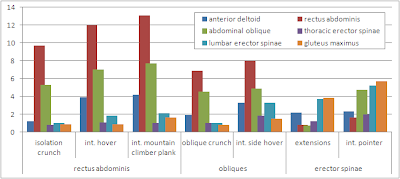 |
| Image 1: Jersey Shore or a fortified core, what do you chose? (img mediabistro) |
Strong core and six-pack abs, anyone?
Most of the aforementioned spring-break warriors would be better off dieting hard, and lifting heavy, but I don't have to tell you that, right? Lean or about-to-be-lean as you are, you are probably more interested in which ab-exercises will complement your balanced workout routine best, right? According to the latest research from scientists at the Pennsylvania State University and Le Mills International in Auckland City, NZ, these are not the classic crunch, the oblique crunch and the extensions, everyone is doing for the rectus abdominis (what people usually call their "abs"), the obliques and the musculature of the erector spinae (Gotschall. 2012).
 |
| Figure 1: Normalized EMG data for the different exercises and muscle groups (data adapted from Gotschall. 2012) |
- Int. Hover with Lateral Arm Reach. Each participant began the exercise in a prone position with the shoulders superior to the elbows, forearms flat with the surface of the floor, shoulders and hips at an even height from the floor, and feet wider than the hips. There [sic!] were instructed to move a single hand laterally from the start position across the floor until the elbow was extended and return to the start position at the cadence of the metronome.
- Int. Balance Mountain Climber Plank. The participants were instructed to start with their shoulders, elbows, and wrists aligned from superior to inferior with their feet hip width apart. We provided the cue of flexing the knee to the opposite elbow at the cadence of the metronome and maintaining a flat upper body while twisting the lower body.
- Int. Side Hover. Each participant began the exercise in a side position with the shoulders superior to the supporting elbow, supporting forearm flat with the surface of the floor, and feet stacked. We then instructed them to hold the nonsupporting hand superiorly above the head arm for 20 seconds.
- Int. Pointer. The participants started in a quadrupedal stance with both hands and knees flat on the surface. We then instructed them to contract their gluteal muscles to lift a single leg and opposite arm to the height of their shoulders at the cadence of the metronome.
 |
| Figure 2: The integrated core exercises; for a detailed exercise descriptions see text above (img Gotschall. 2012) |
- +225% and +250% higher for the int. hover and the int. m.c. plank than for the crunch
- +9% higher for the int. side hover than for the oblique crunch, and
- +66% and +41% higher for the thoracic and lumbar erector for the int. pointer vs. extensions
High EMG values don't equal six-pack abs & 'integrated' exercises require core stability
Just because the EMG activity that is the electrical potential the scientists measure by the means of surface electrodes is higher for a given exercise than for another, this does not mean that the results you will get from this particular exercise are necessarily going to be superior to those you would see if you performed the 'non-integrated' variety. If you read through the descriptions the scientists give as far as the execution of the exercise is concerned, you may also realize that many of the "spring break warriors" are probably not even able to perform those "integrated exercises" correctly, because they require a non-negligible core-strength to begin with; a foundation, the average Facebook addicted 2012 couch potato is lacking and which obviously cannot be build on the 1000-crunches-a-day people like "The Situation" apparently really believe they had build their abs with.
 | ||||||
| Chest | Biceps | Back | Core | Legs | Triceps | Shoulders |
| EMG data for all body-parts -> The SuppVersity EMG Series - Click on the desired body part to see the 'optimal' exercises. | ||||||
- regular plancks, for the rectus abdominis and the obliques, and
- classic pointers, for the musculature of the erector spinae.






